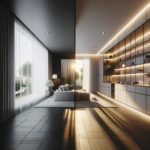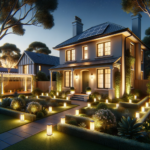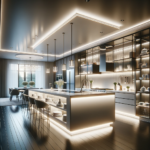Introduction to Energy-Efficient Lighting

The Power of Efficient Lighting

Energy-efficient lighting plays a pivotal role in reducing electricity consumption. By using lighting options that are designed to consume less energy, individuals and households can significantly lower their electricity bills. This reduction in energy usage not only saves money but also helps conserve valuable resources and reduce the strain on the electrical grid.
Saving the Environment and Money
Energy-efficient lighting offers numerous benefits for both the environment and cost savings. Firstly, it helps reduce greenhouse gas emissions by minimizing energy wastage.
Traditional lighting technologies, such as incandescent bulbs, tend to waste a significant amount of energy through heat production. Energy-efficient alternatives like compact fluorescent lamps (CFLs) and light-emitting diodes (LEDs) emit less heat while producing the same or even better illumination levels.
Moreover, by embracing energy-efficient lighting solutions, homeowners can experience substantial cost savings in terms of lower electricity bills over time. Although energy-efficient options may have higher upfront costs compared to traditional bulbs, their longer life spans and reduced energy consumption make them more economically viable in the long run.
Overview of Energy-Efficient Lighting Options
There is an array of energy-efficient lighting options available for consumers today. Compact fluorescent lamps (CFLs) are one such option that has gained popularity due to its improved efficiency compared to incandescent bulbs.
CFLs use about 75% less energy than traditional bulbs while providing similar levels of brightness. They can last up to ten times longer than incandescent bulbs, making them a cost-effective choice.
Another popular choice is light-emitting diodes (LEDs), which offer even greater efficiency and longevity than CFLs. LEDs produce light by passing an electric current through a semiconductor material, requiring significantly less power than other alternatives.
They last up to 25 times longer than incandescent bulbs and are highly versatile, allowing for dimming capabilities and a range of color options. Though LEDs may have higher upfront costs, their remarkable lifespan and energy efficiency make them a smart investment in the long term.
Understanding Traditional Lighting Technologies
Incandescent bulbs: How they work and their inefficiency
Incandescent bulbs emit light by passing an electric current through a thin filament, typically made of tungsten. The resistance of the filament to the electric current generates heat, causing it to glow and produce light.
However, this process is highly inefficient as a significant amount of energy is wasted in the form of heat rather than producing light. This inefficiency leads to higher electricity consumption.
Explanation of incandescent bulb’s filament heating process
When an electrical current passes through the filament, it resists the flow of electricity. This resistance causes the filament to heat up quickly due to its high resistance properties. As the temperature rises, it reaches a point where it emits visible light, creating illumination in our homes or other spaces.
Comparison of incandescent bulbs’ lifespan and energy usage with other options
Incandescent bulbs have a relatively short lifespan compared to other lighting options. On average, they last around 1,000 hours before burning out.
Additionally, incandescent bulbs consume significantly more energy than alternatives like compact fluorescent lamps (CFLs) or light-emitting diodes (LEDs). They are highly inefficient as only about 10% of the electrical energy is converted into visible light while approximately 90% is wasted as heat.
Halogen bulbs: Similarities and differences compared to incandescent bulbs
Halogen bulbs share similarities with incandescent bulbs in terms of their operating principle and appearance but have distinct differences that make them more efficient.
Explanation of halogen gas filling and its impact on efficiency
Halogen bulbs contain halogen gases such as iodine or bromine that surround the tungsten filament inside them. These gases prevent the filament from blackening and deteriorating over time. As a result, the bulb’s lifespan is extended, and it remains efficient for a longer period.
Comparison of halogen bulbs’ lifespan, light quality, and energy consumption
Halogen bulbs generally last longer than traditional incandescent bulbs, with an average lifespan of around 2,000 to 3,500 hours. They also provide better light quality by producing a whiter and more natural-looking illumination. However, although more efficient than incandescent bulbs, halogen bulbs still consume more energy compared to energy-efficient alternatives like CFLs or LEDs.
Exploring Energy-Efficient Lighting Alternatives
Compact Fluorescent Lamps (CFLs)
Explanation of CFL technology, including mercury content concerns. Comparison between CFLs and traditional bulbs: lifespan, light quality, energy efficiency. Tips for proper disposal/recycling due to mercury content.
Compact Fluorescent Lamps (CFLs) are an energy-efficient lighting option that utilizes a different technology than traditional incandescent bulbs. CFLs work by passing an electric current through a tube containing argon gas and a small amount of mercury vapor.
This action causes the mercury atoms to emit ultraviolet (UV) light, which then interacts with the phosphor coating inside the tube to produce visible light. It’s important to note that because CFLs contain small amounts of mercury, proper handling and disposal are crucial to prevent environmental contamination.
In terms of lifespan, CFLs have a significant advantage over incandescent bulbs as they can last up to ten times longer. Not only do they last longer, but they also consume about 75% less energy compared to their traditional counterparts.
However, some people express concerns about the light quality emitted by CFLs. While early versions suffered from flickering and slow warm-up times, today’s CFLs have largely overcome these issues.
They are available in various color temperatures and can deliver warm or cool white light depending on your preference. When it comes to disposing of used CFLs, it is essential to handle them carefully due to their mercury content.
Many communities offer specialized recycling programs or drop-off locations specifically for fluorescent bulbs. By following proper disposal guidelines, we can mitigate any potential harm caused by the release of mercury into our environment.
Light Emitting Diodes (LEDs)
In-depth understanding of LED technology and semiconductor materials used. Advantages of LEDs over traditional lighting options: longevity, durability, color rendering index (CRI), dimming capabilities. Explanation of how LEDs produce different colors through RGB or phosphor coating.
Discussion on CRI’s impact on color perception. Light Emitting Diodes (LEDs) are rapidly gaining popularity as an energy-efficient lighting solution.
They function by passing an electric current through a semiconductor material, triggering the emission of light. Compared to traditional bulbs, LEDs offer numerous advantages that make them highly desirable for residential lighting applications.
One of the most prominent advantages of LEDs is their exceptional longevity. With lifespans averaging 25,000 to 50,000 hours or more, they significantly outlast incandescent and CFL bulbs.
Moreover, LEDs are incredibly durable due to their solid-state construction and lack of filaments or glass components. This durability makes them resistant to shocks and vibrations and ensures they remain functional for extended periods.
In terms of light quality, LEDs provide a wide range of options with excellent color control. They can produce various colors by using RGB (Red-Green-Blue) technology or by applying a phosphor coating to emit white light.
Additionally, the Color Rendering Index (CRI) measures how accurately colors appear under different light sources. LEDs often have high CRI values, resulting in vibrant and true-to-life illumination that enhances our visual experience.
Furthermore, LED technology allows for efficient dimming capabilities without compromising light quality or lifespan. This feature provides flexibility in adjusting brightness levels according to specific needs or desired ambiance.
Factors to Consider When Choosing Energy-Efficient Lighting Options for the Home
When selecting energy-efficient lighting options for your home, one essential factor to consider is your brightness requirements. Different rooms and activities necessitate varying levels of illumination.
For example, task-oriented areas like kitchens might require brighter lights for optimal visibility and focus, while relaxing spaces such as bedrooms may benefit from softer and more ambient lighting. Another aspect worth considering is the color temperature of the lighting.
Color temperature is measured in Kelvin (K) and determines whether the light appears warm or cool. Lower Kelvin values (around 2700K to 3000K) create a warm, cozy ambiance suitable for living areas, while higher Kelvin values (around 4000K to 5000K) produce cooler, bluish-white light commonly used in workspaces or garages.
It is also crucial to evaluate the compatibility of energy-efficient lighting options with existing fixtures and dimming systems. Some technologies may require specific types of sockets or transformers, so it’s essential to ensure compatibility before making a purchase.
Additionally, if you have existing dimmer switches, confirm that the chosen energy-efficient bulbs are compatible with them for seamless operation. By taking these factors into account when exploring energy-efficient lighting options, you can make well-informed decisions that align with your lighting needs and preferences while maximizing energy savings.
Conclusion

In today’s environmentally conscious world, adopting energy-efficient lighting options for our homes is not only beneficial for reducing electricity consumption but also contributes to cost savings and reduces our carbon footprint. Compact Fluorescent Lamps (CFLs) and Light Emitting Diodes (LEDs) offer significant advantages over traditional incandescent bulbs in terms of lifespan, energy efficiency, durability, and light quality.
While CFLs provide an alternative with improved efficiency compared to incandescent bulbs, proper disposal methods should be followed due to their mercury content.
On the other hand, LEDs offer unparalleled longevity and versatility with excellent control over color rendering. They are a highly durable option suitable for various applications.
When choosing energy-efficient lighting options for your home, consider factors such as brightness requirements, desired color temperature, fixture compatibility, and dimming capabilities. By carefully evaluating these aspects and making informed choices based on your specific needs and preferences, you can create a well-lit and energy-efficient environment that positively impacts both your household budget and the planet.









